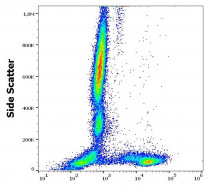ARG62878
anti-CD5 antibody [CRIS1] (FITC)
anti-CD5 antibody [CRIS1] (FITC) for Flow cytometry and Human
Developmental Biology antibody; Immune System antibody
Overview
| Product Description | FITC-conjugated Mouse Monoclonal antibody [CRIS1] recognizes CD5 |
|---|---|
| Tested Reactivity | Hu |
| Tested Application | FACS |
| Specificity | The clone CRIS1 reacts with the cell surface glycoprotein CD5, a 67kDa single-chain transmembrane glycoprotein expressed on mature T lymphocytes, most of thymocytes and B lymphocytes subset (B-1a lymphocytes). HLDA I; WS Code T 29 HLDA III; WS Code T 530 |
| Host | Mouse |
| Clonality | Monoclonal |
| Clone | CRIS1 |
| Isotype | IgG2a |
| Target Name | CD5 |
| Antigen Species | Human |
| Immunogen | stimulated human leukocytes |
| Conjugation | FITC |
| Alternate Names | CD antigen CD5; Lymphocyte antigen T1/Leu-1; LEU1; T-cell surface glycoprotein CD5; T1 |
Application Instructions
| Application Suggestion |
|
||||
|---|---|---|---|---|---|
| Application Note | * The dilutions indicate recommended starting dilutions and the optimal dilutions or concentrations should be determined by the scientist. |
Properties
| Form | Liquid |
|---|---|
| Purification Note | The purified antibody is conjugated with Fluorescein isothiocyanate (FITC) under optimum conditions. The reagent is free of unconjugated FITC and adjusted for direct use. No reconstitution is necessary. |
| Buffer | PBS, 15 mM Sodium azide and 0.2% (w/v) high-grade protease free BSA |
| Preservative | 15 mM Sodium azide |
| Stabilizer | 0.2% (w/v) high-grade protease free BSA |
| Storage Instruction | Aliquot and store in the dark at 2-8°C. Keep protected from prolonged exposure to light. Avoid repeated freeze/thaw cycles. Suggest spin the vial prior to opening. The antibody solution should be gently mixed before use. |
| Note | For laboratory research only, not for drug, diagnostic or other use. |
Bioinformation
| Database Links | |
|---|---|
| Gene Symbol | CD5 |
| Gene Full Name | CD5 molecule |
| Background | CD5 antigen (T1; 67 kDa) is a human cell surface T-lymphocyte single-chain transmembrane glycoprotein. CD5 is expressed on all mature T-lymphocytes, most of thymocytes, subset of B-lymphocytes and on many T-cell leukemias and lymphomas. It is a type I membrane glycoprotein whose extracellular region contains three scavenger receptor cysteine-rich (SRCR) domains. The CD5 is a signal transducing molecule whose cytoplasmic tail is devoid of any intrinsic catalytic activity. CD5 modulates signaling through the antigen-specific receptor complex (TCR and BCR). CD5 crosslinking induces extracellular Ca++ mobilization, tyrosine phosphorylation of intracellular proteins and DAG production. Preliminary evidence shows protein associations with ZAP-70, p56lck, p59fyn, PC-PLC, etc. CD5 may serve as a dual receptor, giving either stimulatory or inhibitory signals depending both on the cell type and development stage. In thymocytes and B1a cells seems to provide inhibitory signals, in peripheral mature T lymhocytes it acts as a costimulatory signal receptor. CD5 is the phenotypic marker of a B cell subpopulation involved in the production of autoreactive antibodies. Disease relevance: CD5 is a phenotypic marker for some B cell lymphoproliferative disorders (B-CLL, Hairy cell leukemia, etc.). The CD5+ popuation is expanded in some autoimmune disorders (Rheumatoid Arthritis, etc.). Herpes virus infections induce loss of CD5 expression in the expanded CD8+ human T cells. |
| Function | May act as a receptor in regulating T-cell proliferation. [UniProt] |
| Research Area | Developmental Biology antibody; Immune System antibody |
| Calculated MW | 55 kDa |
| PTM | Phosphorylated on tyrosine residues by LYN; this creates binding sites for PTPN6/SHP-1. |
Images (2) Click the Picture to Zoom In
-
ARG62878 anti-CD5 antibody [CRIS1] (FITC) FACS image
Flow Cytometry: Human peripheral whole blood stained with ARG62878 anti-CD5 antibody [CRIS1] (FITC) (20 µl reagent / 100 µl of peripheral whole blood).
-
ARG62878 anti-CD5 antibody [CRIS1] (FITC) FACS image
Flow Cytometry: Separation of human CD5 positive lymphocytes (red-filled) from neutrophil granulocytes (black-dashed). Human peripheral whole blood stained with ARG62878 anti-CD5 antibody [CRIS1] (FITC) (20 µl reagent / 100 µl of peripheral whole blood).
Clone References









